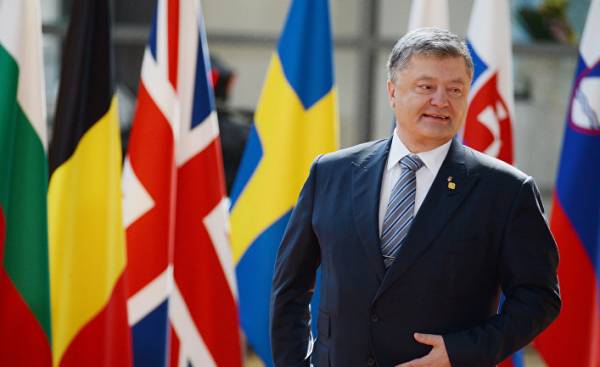
The main question about the future of Ukraine, which is still no clear answer today concerns not only and not so much its internal Affairs, economic transformation and social stability — themes that are often heard in the media and debate among experts. Ultimately, a decisive challenge to Kiev in the next few years, the issue of protection of Ukrainian national security of the Russian hybrid war against Ukraine. First and foremost, this concerns the deterrence of possible further military attacks deep into the Moscow of the Ukrainian state, such as aerial bombardment, artillery shelling, missile strikes, or the advance of ground troops beyond the occupied territories. The latter could, for example, happen if the Kremlin tries to create a link between Russia and Crimea along the Azov sea, especially in the case of the failure of the Russian construction of the Kerch bridge.
In this context, it makes sense to identify the following six possible options for the future international positioning of Ukraine. These scenarios will require from Kiev, the West and Moscow — for example, after Putin’s departure — different conceptual approaches, mutual signals and cooperative or antagonistic actions. They can lead to very different consequences not only for Ukraine but for the whole of Europe — if not for mankind (in view of the following relationship between the territorial integrity of Ukraine and the international regime on the non-proliferation of nuclear weapons). As will be illustrated, the relative chances, risks and possibilities of realization of a scenario dramatically different from each other. However, it makes sense to discuss all six scenarios in roughly equal measure, as they are all actively discussed in the expert community and international diplomacy, and sometimes in the mass media. Has sense to compare today’s relative likelihood of their fulfillment and openly say about utopianism, desirability, risk, attraction, gloominess, etc. of their future implementation.
Moreover, in the following years cannot be ruled out, no new shocks or transformation of international security, no sudden changes in the internal situation involved in the “Ukrainian conflict” of different nation-States and intergovernmental organizations. As a result of these mutations conditions set out the six scenarios, the relative probability of these realizations can decrease or increase compared with the present situation. Here are some of the scenarios are based on the current international situation seem simple fictions. However, prior discussion today has a certain meaning in that case that in the next years there will be sharp turns, for example, in Ukraine, Russia, the United States and/or the European Union. Recent years have shown that even the most — seemingly — incredible new developments cannot be ruled out completely.
Save scenario as a “gray zone”, today seems the most likely
This kind of, on the one hand, political upheavals, or, on the other hand, progressive jumps can for Ukraine and its friends to provide a new “window of opportunity”. If such a window is suddenly open — Kiev, Brussels, Washington and other players will need, perhaps, to act quickly and decisively to not miss this historic moment. It is in this case, i.e. to be ready for the most dramatic turn of events discussed here and is only hypothetical options for Ukraine’s future. They can be as fantastic as they seem today — or, conversely, become quite possible, if the world changes significantly.
First scenario: Ukraine (together with Georgia and Moldova) remains in the current geopolitical “grey zone” of Europe and received only informal support for its security from the West
A simple extrapolation of the current situation of Ukraine, Moldova and Georgia without a significant change in their international status is, to date, the most likely scenario in the coming years. Possible new development inside of this scenario, such as different bilateral partnership projects and agreements. But in the end, these individual initiatives is likely to leave the level of institutional involvement of all three countries, i.e. the lack of their institutional inclusion in the European security system similar to today’s. As a result, on the one hand, it is fair to say that only the discussion of various options for the future in this first scenario is really realistic discussion, and that only attempts to improve this scenario makes political sense for Ukraine.
On the other hand, the obvious disadvantage of this Ukrainian, Georgian and Moldovan future is that it will be essentially a continuation of the situation that has developed since 1991. This scenario will continue to reproduce the set of circumstances that led to the disaster of 2014. Partial Western assistance to Ukraine, Moldova and Georgia in the form of financial support, various schemes of cooperation and supply of some arms, in the worst case, will be seen as a distraction from the task more creative and substantive solutions to the fundamental problems of the international situation of these three countries.
Meticulous work on the gradual improvement scenario “gray zone” because of its high probability for the next years, of course, necessary — and, owing to uncertainty about the alternatives to it, even the primary. However, excessive or even exclusive focus on only this purpose can result in both Ukraine and the West to forgetfulness about the fact that this scenario will ultimately mean continued geopolitical threat “holes” in Europe. Yet this fragile model of international relations in Eastern Europe is not replaced by some serious structure, it could lead to another big collapse than that which occurred in the 2014th year. The idea that Ukraine, Moldova and Georgia should and can in themselves become strong enough to confront Russia is an honorary and good-looking. But she ultimately naive, if not daft. The fact that these countries themselves can cope with the new full-scale Russian military invasion, including air and missile attacks — and what about this nightmare you need to talk seriously to discuss questions of basic national security of the three countries is only a sweet dream.
Second scenario: In the framework of the Grand bargain between Russia and the West Ukraine will have certain guarantees of security, but may lose part of its territory and/or sovereignty.
While the first option is by far the most probable, the second is sometimes called “Finlandization” has become over the past three years, the most popular among many politicians, diplomats, observers in Western Europe and some analysts of Russia. The idea about the big deal between Moscow and the West is often mentioned in the media and in expert discussions. In principle, Ukraine should be the country most interested in a stable, comprehensive and fair peace with Russia. However, steady deal with Moscow seems unlikely without fundamental changes in the current political regime of Russia or at least its foreign policy priorities. Today’s Kremlin is unlikely to truly recognize the sovereignty of Ukraine or agrees with the actual decision on the Crimea. Except that, we can assume possible future withdrawal of Russia from the Ukrainian Donbass in exchange for the lifting of most Western sanctions.
It is likely that Moscow will require for progress plus concessions from the West, as an official exception, the possibility of future entry of Ukraine into the EU and NATO. The Kremlin also probably will not give up Crimea and would not stop supporting their puppet regimes in Transnistria, South Ossetia and Abkhazia. Thus, such an asymmetric deal that ignores the interests especially of Kiev, would have become actual by the refusal of the US and the UK of their promises in the famous Budapest Memorandum on security assurances of Ukraine in 1994. (The title of this document is often incorrectly translated in Ukraine as a “Memorandum of [alleged] security assurances”, although in the English version refers to “security assurances”, not “security guarantees”.) Thus such a possible agreement further undermined the already cracked in 2014, the year of the global regime of nonproliferation of nuclear weapons, which is said below in more detail.
Besides, such a transaction would repeat various previous failed attempts to come to an understanding between the West and the Kremlin of the former Soviet Union, through collective bargaining and signing of multilateral instruments. In the Budapest Memorandum of 1994, the year with the United States, Britain and Ukraine, the Kremlin in exchange for the complete transfer of the Ukrainian nuclear Arsenal of Russia assured the world in its respect for the territorial integrity, national borders and political sovereignty of Ukraine. At the Istanbul OSCE document of 1999, Russia promised to withdraw its small military unit in Transnistria. In the Russian-Georgian peace Treaty of 2008 year achieved through the mediation of the EU, the so-called “Sarkozy plan”, the government of Russia agreed to withdraw its troops from South Ossetia and Abkhazia. In the Geneva Declaration, the Minsk Protocol and the Minsk Memorandum of 2014 year, and in the Minsk agreement 2015, Moscow agreed to the de-occupation of Donbass.
None of the Russian promises in these multilateral agreements (as, in General, the number of bilateral contracts of Russia with Ukraine, Moldova and Georgia) has not been fulfilled, although Moscow, in varying degrees, participated in the initiation of the signing and development of these texts. The conclusion of another similar agreement with Russia can have the same disappointing result. At worst, it might tempt the West to subscribe to a permanent violation of political sovereignty of Ukraine. This result, on the background of the events and agreements concerning the Ukrainian nuclear Arsenal of the 1990s, further undermined the logic would defiantly break with Moscow 2014, the year of the international regime for the nonproliferation of nuclear weapons.
Third scenario: as promised at the summit in Bucharest in 2008, NATO offered Ukraine and Georgia action Plans for membership (map) and, ultimately, adopt these countries are members of the Alliance.
Whereas the big deal between Russia and the West is the preferred option to resolve the conflict around Ukraine among many Western and Russian observers in Ukraine and Georgia, the most popular solution to the problem of security of these countries is their speedy accession to NATO. (Moldova in 1994, the year proclaimed himself in permanent non-aligned state.) A relative majority, not only of politicians and intellectuals of the two countries, but also the Ukrainian and Georgian societies today firmly supports NATO membership. In 2008, Ukraine and Georgia have officially applied for NATO membership. Although these statements had not led to the granting to applicants of the map, the Alliance pledged in the final Declaration of its summit in Bucharest that Ukraine and Georgia “will become members” of the Alliance — although he did not specify how and when it happens.
The fundamental problem with this scenario is that NATO is not a supranational organization. The decision on acceptance of new members of NATO decide not bureaucrats or the military, many of whom are friends of Ukraine and Georgia. Instead, all member countries of the Alliance in the framework of the North Atlantic Council shall unanimously agree to an extension. Prior to the hypothetical vote of the North Atlantic Council, statement by Georgia and Ukraine to join NATO probably would have found considerable support among the political elites of the member countries of the Alliance from Eastern Europe and North America. However, since each country has veto power, the chances of a unanimous positive vote would be today, however, negligible. Most likely will always be, at least a few Western European countries that impose its veto on such a NATO expansion — until, until you resolve territorial disputes between Kiev and Tbilisi with Moscow.
Paradoxically, Ukraine and Georgia, apparently, only will become members of NATO, when they will be gone and you need ie if and when they resolve their conflicts with Russia. However, many Ukrainian and Georgian politicians, experts and diplomats today are investing most of their time and their energy to promote the idea as fast as possible the entry of their countries into NATO. They are not only promoting this vague scenario in their countries and put pressure on their colleagues in the West, that they somehow solved the problem of membership, despite the fact that the probability of a single support of this step, all 29 members of the Alliance in the coming years is close to zero. Although the motivation of the Pro-NATO Georgian and Ukrainian politicians and activists are clear that their ongoing attempts to achieve something in this plan at the moment is not only useless. They are partially counterproductive, as it takes away from Kiev, Tbilisi and its Western partners from finding more promising ways to improve the structural security of Georgia and Ukraine during the period of time until the accession to NATO in the end will not be really possible.
Fourth scenario: the EU Accession as a tool to strengthen security of Ukraine, Georgia and Moldova.
In contrast to the insurmountable political obstacles to the further Eastern expansion of NATO as long as the conflict continues, Ukraine and Georgia with Russia, the future EU membership of the three associated countries of the Eastern partnership — a far less politicized issue. The EU is not a defence Alliance, making its expansion less risky for countries-members of the Union and less threatening to the Russians, most of whom until recently had experienced a significant level of sympathy for the EU. Against this background, the chances, the challenges and trajectories of EU accession, on the one hand, and NATO on the other, differ.
However, the official prospect of EU membership Kiev, Tbilisi and Chisinau no. However, in a time when the three countries fully embody its already signed the Association Agreement with the EU and thus “Evropeiskiy” their national legislation and state management, the issue of accession of Ukraine, Georgia and Moldova to the Union there will be a lot of supporters in the Eastern-Central as in Western Europe. Therefore, contrary to popular belief, the accession of these three countries in the EU are not so unlikely. Such a step would also not trivial in relation to the security of the three countries.
The Association agreement concluded by these three former Soviet republics in the 2014th year, are exceptionally large and comprehensive contracts in the coming years will be to gradually strengthen their relationship with the EU. In fact, the implementation of these super-contracts in itself will make Ukraine, Moldova and Georgia the European economic and legal space. When Agreements are fully implemented and operate in many spheres of public life in the three countries, the final step towards full membership in the EU is already relatively easy.
Against this background, it is likely that after the majority of chapters of the Association Agreements are implemented, the three countries will get the official status of a candidate member from Brussels. Probably also that of the consequent accession negotiations will be shorter than in the case of earlier arrivals of countries in the EU, because many of the key issues will be resolved in the process of translating a huge existing Association Agreements. Although the contract is not officially concluded in order to prepare three Eastern partnership countries to join the EU, in fact they are doing just that.
The EU, however, is not a military Alliance and thus does not give such unambiguous security guarantees as NATO. However, members of the Union institutionally related so deeply and thoroughly that they can’t be close geopolitical allies. Thus, the accession of Ukraine, Georgia and Moldova to the EU will greatly improve their position in the field of security and will be politically less complex than NATO’s further enlargement.
Some politicians, diplomats and experts of the three countries understand the potential value of EU membership to the resolution of security problems, Kiev, Tbilisi and Chisinau and are therefore actively working on it. However, a special depth and breadth of the three Association Agreements mean that their implementation will require many years. This means that — although politically, the accession to the EU and easier than in the NATO — Ukraine, Georgia and Moldova will not soon be able to apply for EU membership. The question remains, what to do until their likely future accession to the Union.
Fifth scenario: getting the status of the so-called Main non-NATO ally of the United States and/or the conclusion of a security agreement on the basis of the Budapest Memorandum.
After the collapse of the Soviet Union, Ukraine inherited the third largest nuclear weapons Arsenal, which greatly exceeded the total number of nuclear warheads that are then available to China, UK and France. Of course, in Kiev in the early nineties it was not possible to use most of these weapons. However, this vast Arsenal, as well as significant manufacturing capacity and engineering experience of Ukraine has allowed Kiev to create a small but functional and quite threatening nuclear forces.
However, Kiev has decided to abandon all its nuclear weapons, equipment, and materials to join in the mid-1990s to the world the Treaty on the nonproliferation of nuclear weapons (NPT) as a state without nuclear weapons. Already suspecting then the Russian irredentist threat, the Ukrainian government, however, insisted that Ukraine for abandoning its nuclear Arsenal received security guarantees from the so-called countries depozitarul of the NPT, i.e., from Washington, London and Moscow, which signed the Budapest Memorandum in 1994.
Of course, this Memorandum is not a full-fledged international Treaty. He has provided Ukraine does not “guarantee” as it is often presented in the Ukrainian media, and “assurances” (assurances) of the security. However, since the Budapest document is closely related to the NPT, Moscow in 2014 violated not only Ukraine’s territorial integrity. Indirect victim of the Russian annexation of Crimea and intervention in Donbas has also become a international confidence in the validity of the Treaty on the nonproliferation of nuclear weapons. Against this background, Ukraine is in the future to try to convince Washington and London confirm his assurances of 1994 year and to do this not only because of the solidarity with Ukraine, and for the sake of the future strength of the global nonproliferation regime.
Standard format for security, which the United States applies to selected partners around the world — it’s called status of the Main ally outside NATO, which envisages a number of special opportunities for cooperation in the sphere of security and may be accompanied by a Pact of military aid between Washington and its ally. In December 2014 the U.S. Congress has seriously considered granting this status to Ukraine, but at the last minute this provision was excluded from the bill. In March 2017, the Verkhovna Rada adopted a resolution in which it is directly asking Washington to declare Ukraine as the Main ally outside NATO. In the future, maybe even worth it to Kiev to seek a tripartite agreement between Ukraine, the US and the UK on the basis of the promises of Washington and London to Kiev in the Budapest Memorandum of 1994.
Obvious reason why such a Treaty and military cooperation yet is that the US and the UK then risk being embroiled in the conflict of Ukraine with Russia. On the other hand, such a step would have raised the stakes for Russia in its hybrid war against Ukraine, and thus could help to curb future attacks on Moscow. Moreover, the provision of Ukraine is more serious guarantees of the security of the US and the UK than assurances under the Budapest Memorandum would strengthen the General credibility of international law in General and the NPT in particular. Against this background, Washington and London will one day be able to decide what they still need to take that risk and make a “upgrade” Budapest transactions 1994 of the year — not only for the safety of Ukrainians, and in the interests of further functioning of the nonproliferation regime. In this case, Ukraine will significantly increase its international involvement and to move away from his current situation in the European “grey zone” of security.
Paradoxically, such a development would be in the fundamental strategic interests of the Russian state — a fact which, of course, the cynical “Kremlin politics” vigorously would deny. The perception of Russia as a world power and its international influence is more closely associated with relative gravity and exclusivity of its nuclear Arsenal than, for example, in the case of the United States, China, France and the UK. The international weight of these four countries, however, also is based on their status as official nuclear powers under the NPT. But their status and reputation are connected not only with their nuclear weapons, but other factors, such as the greater economic power, high academic potential and different technological innovations are more or less dynamic Nations.
The preservation of the global status and weight of Russia as a country whose achievements in the fields nevoennyh more modest than other nuclear powers, is therefore particularly closely associated with the future compliance with the NPT. If different countries of the world will lose their confidence in the effectiveness of the NPT and thus begin to acquire nuclear weapons, it will reduce, primarily, the relative international weight of Russia. Moscow will be more difficult than other official nuclear powers to compensate for the gradual reduction of its possessions of nuclear weapons by other levers of influence. The relative status of the losses from a possible future increase in the number of countries with nuclear weapons Russia will have more than any other country in the world. Therefore, Moscow would have to be — in view of the specific international geopolitical position of Russia — the most vocal guarantor of the NPT. But, of course, the last operation of the Kremlin in Ukraine contradict in the most different relations purposes which could be defined as the fundamental national interests of Russia — and not only in its relative international weight.
Sixth scenario: Ukraine, Georgia and Moldova, as well as a number of post-Communist member States of NATO to create a coalition that embodies the old Polish idea of “Intermarum” (Intermarium).
The geopolitical situation of Kiev, Chisinau and Tbilisi — on an abstract level — similar to the situation of the new States of East Central Europe, which appeared after the First world war, such as Poland, Czechoslovakia, Lithuania, Latvia, Estonia. As these States in the interwar period, Ukraine, Georgia and Moldova are now in a kind of geopolitical “hole”, and their sovereignty is challenged by revisionist powers. Russia has managed to make all three of these countries “failed States” by active incitement and targeted support in them separatist movements. Without the help of Moscow, six separatist units on the territory of these countries would not be. Indirectly, Russia is also involved in separatism in Azerbaijan, where Moscow is helping Armenia, which in turn supports the separatists of Nagorno-Karabakh.
Georgia, Ukraine, Azerbaijan and Moldova are currently already included in the so-called Organization for democracy and economic development, known by the acronym GUAM. The Union of the four countries in this coalition vaguely reminiscent of the interwar Eastern European project called “Intermarium” (i.e. “the land between the seas”). After the collapse of empires and other Polish politicians of the former colonies of various empires in Europe developed the idea of uniting their Nations between the Baltic, Black and Adriatic seas. The main purpose Midmore and similar projects was to increase the relative security of these by themselves are weak States, creating a Union that will make the buffer zone between potential revisionist Germany and Russia/USSR more secure. But this idea was never implemented — and could not stop the beginning of the Second world war.
GUAM same as other similar organization, created in 2005, the so-called Community of democratic choice, become a reality. However, these coalitions according to their composition and statutes are too weak to resist military intervention and other so-called “active actions” of Russia in the current “grey zone” between NATO on the one hand, and the Organization of collective security Treaty, on the other. The closest Western neighbours of Ukraine — Poland, Slovakia, Hungary, Romania and other Eastern countries-members of NATO should be interested in stability and security especially of the Ukrainian state. The possible collapse of the Ukrainian state as a result of the new Russian attack would affect them in different ways.
But, despite this commonality of interests of the Nations of East Central Europe, has still not been any significant action to create the appropriate underlying security architecture of the countries of the region. And this is despite the fact that there is already a kind of model for a similar agreement between member and non-member of NATO in the region. In 2010, Azerbaijan signed with Turkey the Agreement on strategic partnership, which includes an article about possible military aid to Ankara to Baku. Thus not only the US in his various alliances outside NATO, but Turkey its agreement with Azerbaijan has already crossed the “red line” giving ratified by the security guarantees of NATO outside of the Alliance.
However, for Poland, Romania and other Eastern European neighbors of Ukraine the idea of their participation in anti-Kremlin coalition outside of NATO, apparently, uninteresting. Although the idea of Intermarium sometimes mentioned the Polish politicians, including the current President of Poland, Andrzej Duda, over the last 25 years, Warsaw has not yet taken any concrete steps for its implementation. Today, Warsaw seems to be more interested in the construction of the anti-German East European coalitions in the EU than in solving the problems of security on the Eastern border of Poland.
The usefulness of the EU or NATO in the case of the apocalyptic, but it is a possible scenario for the Ukrainian state, i.e., its decay, for the Western neighbors of Ukraine would be limited. It is unclear, for example, how Brussels could help Poland, Slovakia, Hungary and Romania, with the influx of several million Ukrainian refugees or explosion largest nuclear power plant in Europe in the Zaporozhye region. Do Warsaw that NATO troops will begin to fire on Ukrainian refugees after the exhaustion of the maximum number of refugees that Poland is willing to accept, i.e., for example, after a third of a million immigrants from Ukraine in the next few weeks? Lee hopes in Bucharest that the EU will impose strict visa regime for Zaporizhia radioactive particles when they start to massively cross the Schengen area through the Romanian-Ukrainian border?
The probability of a complete collapse of the Ukrainian state and its apocalyptic consequences, of course, low. However, the rates for the Eastern members of NATO in the stability of Ukraine is enormous, and NATO’s capabilities to help in this regard (due to the fear of Western Europeans) are restricted. Against this background, the relative passivity, in particular, Warsaw, Bucharest, Budapest and Bratislava to overcome Eastern European “gray zone” is surprising. This inefficiency could be related to the fact that the opinion of many Central-Eastern politicians, diplomats and even some experts in your region is “astronomical.”
In not fully conscious “astronomical” the imagination of Europe among the post-Communist elites, the continent is divided into good the planet of the EU and NATO, and the bad “planet” of all other countries. Finding the right “planet” in this post-geographical viewpoint, decides all major issues of security. What is important is that nor in any way to enter into some connection with the other “planet”, not to be involved in her problems and thereby be constricted in the “good European” in the “wrong post” area. In the brave new world of Central-Eastern politics, bad planet is so far from good that her problems are insignificant to the happy inhabitants of the planet of the EU/NATO.
There are of course other reasons for the fact that periodically pop-up the idea of creating a land between the seas is still unfulfilled. So, the recent nationalist turn in domestic and foreign policy of Poland led to new stresses in the Polish-Soviet and Polish-Ukrainian relations. Bad palmitinovaja official policy of historical memory of Kiev — especially in respect to the interpretation of values and the perpetuation of the leaders of the OUN-UPA — along with this Polish twist. In particular, it concerns the activities of the new leadership of the government of the Ukrainian national memory Institute (the Institute), consisting of historians, which are not published in serious academic journals. Inept initiatives of the Institute and similar institutions greatly facilitated the utilization of the new Polish-Ukrainian voltages of the Russian propaganda machine.
Conclusion
None of these six scenarios is not encouraging. First, the preservation of the “gray zone” now seems the most likely. But it may be based on the known past experience, in the end — a dead end. It remains unclear whether even stronger than it is today, cooperation, adaptation, and consolidation in this scenario to replace or compensate for formal and sustainable institutional integration of Ukraine, Georgia and Moldova in a more or less significant international coalition to such an extent that the security of these three countries will substantially increase.
The other five scenarios, in contrast, provide some international legal mechanisms have serious security in today’s “gray zone.” They would have fundamentally changed the geopolitics of Eastern Europe by signing new big contracts. But these scripts that are in different dimensions are advantageous for Ukraine, Georgia and part of Moldova, today is unrealistic, if not fantastic. However, these five scenarios in one way or another could become possible in the future, if there will be significant changes in domestic or foreign policy of these or those involved in the Eastern European region countries and organizations.







